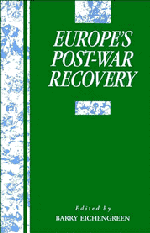Book contents
- Frontmatter
- Contents
- List of contributors
- Preface
- Part I Introduction and survey
- Part II The Marshall Plan
- Part III Other international initiatives
- Part IV Country studies
- 8 Germany and the political economy of the Marshall Plan, 1947–52: a re-revisionist view
- 9 “You've never had it so good?”: British economic policy and performance, 1945–60
- 10 “Belgian miracle” to slow growth: the impact of the Marshall Plan and the European Payments Union
- 11 France: real and monetary aspects of French exchange rate policy under the Fourth Republic
- Part V Synthesis
- Index
10 - “Belgian miracle” to slow growth: the impact of the Marshall Plan and the European Payments Union
Published online by Cambridge University Press: 07 September 2010
- Frontmatter
- Contents
- List of contributors
- Preface
- Part I Introduction and survey
- Part II The Marshall Plan
- Part III Other international initiatives
- Part IV Country studies
- 8 Germany and the political economy of the Marshall Plan, 1947–52: a re-revisionist view
- 9 “You've never had it so good?”: British economic policy and performance, 1945–60
- 10 “Belgian miracle” to slow growth: the impact of the Marshall Plan and the European Payments Union
- 11 France: real and monetary aspects of French exchange rate policy under the Fourth Republic
- Part V Synthesis
- Index
Summary
The economic reconstruction of Belgium after the Second World War took place under conditions largely different from those in neighboring countries. A particular configuration of favorable circumstances permitted a very rapid economic recovery, subsequently known as the “Belgian Miracle.” But this miracle was shortlived. From the mid 1950s the Belgian economy was already showing signs of weakness that put it at a disadvantage relative to its competitors: relatively slow growth, insufficient investment, little advance in productivity. The legacy of this period may still be a burden forty years later.
This chapter reviews the characteristic features of Belgian growth after the war and examines the way in which they were influenced by the Marshall Plan and the European Payments Union. The relative prosperity of the Belgian economy in 1948 is first considered. Then the structural weaknesses which had appeared by the late 1950s and their principal causes are discussed. Finally, some hypotheses about the role of the Marshall Plan and the European Payments Union in the relative weakness of the Belgian economy are proposed.
It is argued here that: 1) the resumption of growth in Belgium was particularly rapid after the war thanks to the limited character of wartime destruction, to the specialization of Belgian industry in producer goods in strong demand, and to a timely and effective monetary reform itself reinforced by social reform. 2) The relatively slow growth in Belgium during the 1950s can be explained by its aging industrial structure, by the defensive nature of investment, and by the loss of competitiveness arising from a combination of high wages and a high exchange rate.
- Type
- Chapter
- Information
- Europe's Postwar Recovery , pp. 271 - 291Publisher: Cambridge University PressPrint publication year: 1995
- 2
- Cited by



